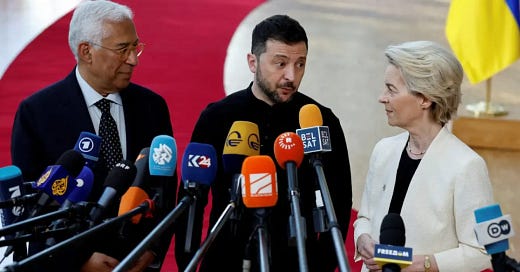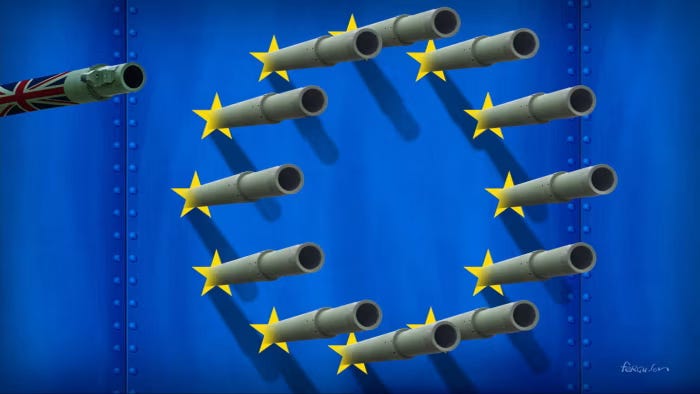Europe’s industrial prosperity, the time is now.
A plan to ensure a golden age of technology and security independence
“The first step in winning the future is to imagine it” Napoleon Bonaparte
You probably won’t like what I’m about to say. But here it is: the West, as we know it, is gone. NATO? On life support. The EU must disrupt itself or face calls to be disbanded. Some suggestions on how to ensure European sovereignty and abundance.
Amid all the chaos and headlines of the last few weeks, two things are clear:
Europe has spent too long outsourcing its security, industrial capacity, and foreign policy
The US is shifting its priorities to the Indo-Pacific, withdrawing from alliances which are not strategic or good for the US bottom line.
For decades, Europe bet on globalization, assuming that peace and stability were default settings. That assumption is now dead. The post-Cold War order has fragmented, and Europe has no choice but to wake up—or be left behind.
The EU, which was conceived as an economic project, behaves more like a social and regulatory one, hamstrung by bureaucratic inertia and Germany’s self-imposed debt brake. European leaders claim they’re waking up, yet their response is more summits, committees, and development funds—the kind of bureaucratic inertia that prevents private enterprise from scaling technological solutions at speed.
The EU needs to shift from being reactive to proactive, or risk its existence being called into question. It needs to make it’s own choices. Let’s look at how we can ensure Europe’s continued success.
The Ukraine shift
Ukraine has redefined warfare. Last year, Ukraine consumed 2.2 million drones (increasing to 4.5m in 2025). They gave drones and electronic warfare (EW) a completely new command structure, proving that modern war isn’t just fought with tanks and missiles but with FPV drones, AI-enabled targeting, and battlefield autonomy. Many Ukrainian forces now operate more like tech-first hardware hackers, than infantry men (see this video on Russian forces reverse engineering Ukrainian drones). With drones able to take down much larger and more expensive [payloads], Warfare cost assymetry has exploded. The game has changed.
Yet many NATO countries have not adapted to this change, leaving their forces with ourtdated and expensive equipment. The gap between frontline needs and NATO acquisition strategy, is well summarised in this piece by Matthew Wright, VP of Operations at Delian1:
“There was also a wide gap in how AI is being applied. At Brave1 (Ukraine), the emphasis was on AI’s potential to transform low cost, highly scalable platforms….In London, AI’s role in conflict was almost an after thought. It was instead more of a back office efficiency tool, or simply a convenient trend for consultancies to now sell to MoD”
Some have already gotten the memo. The US is accelerating defense innovation, overhauling shipbuilding, reforming software acquisition, leaning heavily into autonomous and attritable drones and embedding cutting-edge technology into its defence doctrine. Europe is slowly defrosting from a peacetime mentality.
The emerging AI supply chain
As we’ve covered repeatedly in this publication, AI is the tip of the spear for new defensive capabilities. FPV drones, battlefield autonomy, ISR, counter-UAS, cyber—many aspects of modern defense are AI-driven. AI both expands capabilities, and collapses the cost of those capabilities. But AI isn’t a system you procure once; it’s a supply chain. A constant, iterative loop between inference, data, software, and compute infrastructure (fabs, chips, datacenters). And here’s the problem—Europe doesn’t control much of that stack.
To thrive, Europe must build independent defence and AI supply chain. That means investment in sovereign compute, partnerships between AI labs and defense companies, and a direct pipeline between AI startups and battlefield deployment. All of this new capability must be acquired from private enterprise, largely startups.
It’s always darkest before the light, some glimmers of hope
But there are signs of movement. After years of hints, the Trump bomb has woken Europe up just a bit. Whilst arguably Trump’s strategy is less insane than it seems, amidst the chaos he is making unforced political and economic errors. Errors that Europe should be capitalising on, as arguably the last bastion of liberal democracy. Autonomy is not merely about drones, but about Europe manifesting its own future.
Europe should not talk itself down. The EU and UK combined has bigger purchasing power than the US, with a significantly lower debt-to-GPD ratio.
There are some signs of life but significant changes still need to be made. The EU just passed a new Clean Industrial Deal, which focuses on decarbonising industrial capacity and cutting project red tape. The EU proposes sourcing critical minerals via a centralised procurement process —jeez. Notably, there is no plan for the sovereignty of those materials or supply chains. There is a new, initiative called ReARM Europe, which allows EU member states to increase their own defence spending (!). The incoming German Chancellor, Merz, is pushing to reverse Germany’s disastrous debt brake. The UK’s MoD has started procuring drones from Anduril and is pushing to scrap ESG rules preventing investment in defence funds and companies. Helsing partnered with Mistral on an LLM for national security. Rheinmetall is repurposing automotive factories for defence. It's a start.
Far bigger changes are needed to modernise Europe’s technological independence and defensive capabilities. So here are some suggestions:
Restructure procurement for speed + innovation. Current EU acquisition models are too slow and risk-averse. Defence procurement should prioritise SMEs, new technologies, and software. Implement DARPA-style challenge programs for European startups. Create fast-track “operational testing” programs where battlefield-ready tech is deployed in real conflicts. Prioritise software acquisition given the speed at which it can be implemented.
Europe should pick up the ‘soft power’ slack that the US is leaving behind: croissants, museums and espressos? Great, leverage that. As the US pulls back from non-strategic commitments, Europe should fill the gap by leading on diplomacy, trade partnerships, and security arrangements, particularly in Asia, Africa and the Middle East
Harmonise Test & Evaluation (T&E) for defence startups: The EU’s fragmented system makes it hard for startups to scale. Prior initiatives such as Defence Test and Evaluation Base (DTEB) have clearly not worked
Create an EU-Wide Defense Innovation Agency: Europe needs its own version of the DIU—a central hub to bridge startups and military contracts. Put out RFPs and get competitive bids. Improve payment timelines for successful SMEs
Enable cross-border defence M&A: European defense remains too fragmented. A cross-border MBDA-style single market in drones, AI, and cyber could create scale quickly
Secure European supply chains: The EU depends on China for critical components, including batteries, rare earth metals, nuclear and semiconductors. The EU needs an industrial strategy that subsidises building home grown businesses in critical supply chains similar to the US’ Inflation Reduction Act (IRA), and priotises cheap and abundant power and compute
Integrate drone & EW units within forces: Establish dedicated drone brigades, modeled after Ukraine, deploy engineers at the battalion level to drive rapid adoption
Build a sovereign AI supply chain: from lithography, to fabs, to chips to datacenters. We need soverign compute at scale and fast. Analyse dependencies and vulnerabilities and subside and deregulate, allowing private enterprise to fill the gaps. Exert more export sanctions and make better use of ARM and ASML. Roll back the EU AI Act.
A decade of European abundance - a choice, if we move now
It can modernise, scale, and lead—leveraging its industrial and technological base to secure a more autonomous and prosperous future.
Or it can remain a slow-moving bureaucracy, waiting for the next crisis to force its hand.
The window is still open and the time is now.
Disclaimer: A fund managed by Sam Cash is an investor in Delian Alliance Industries







Great thoughts. Well written